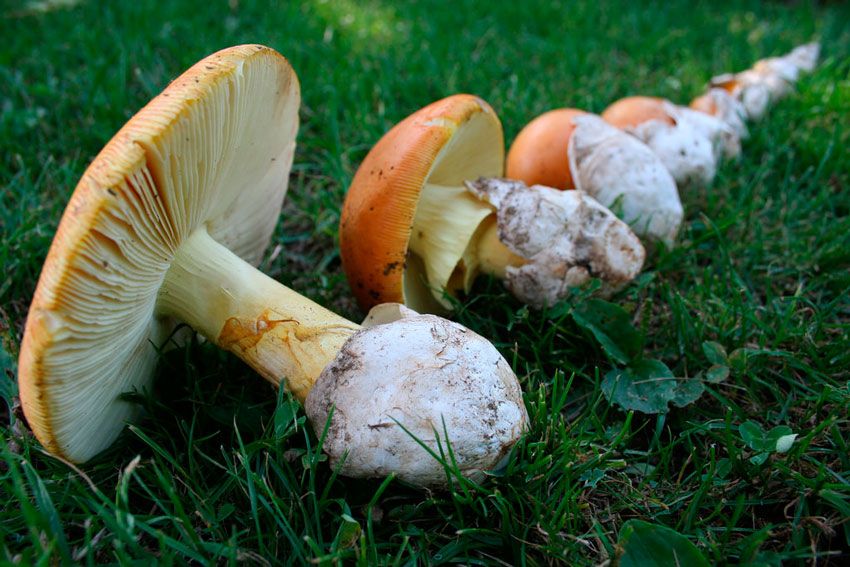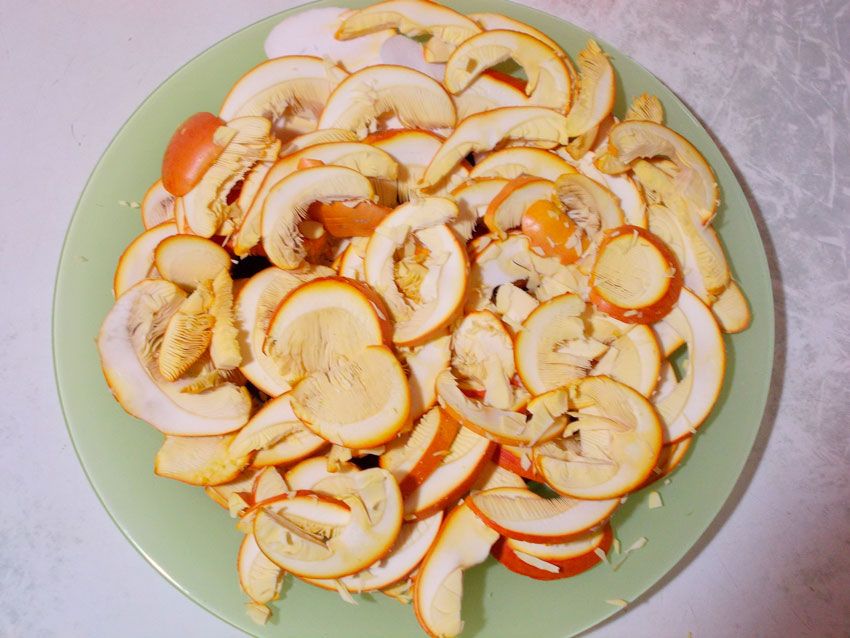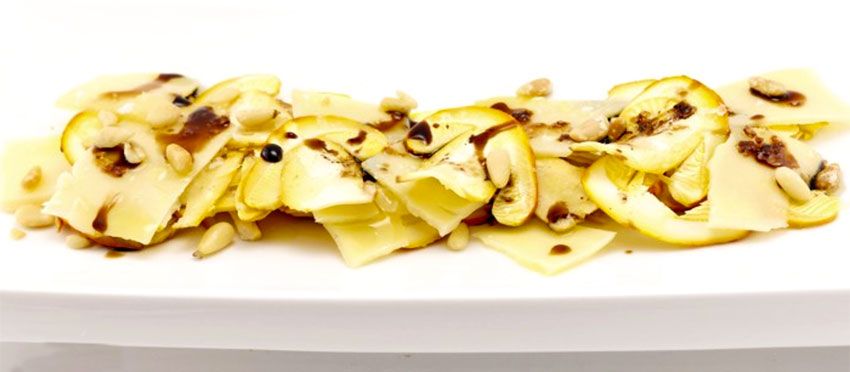Amanita caesarea, 'oufs de roi, oronjas, tanas
2 years ago · Updated 6 months ago

- Amanita caesarea: the queen of mushrooms
- King's egg, secrets and characteristics
- Amanita caesarea, a mushroom with a lot of history
- Characteristics of the Caesar's mushroom
- Amanita caesarea, where to find king eggs
- Tanas, hidden queens
- When should you look for Caesar's mushroom?
- Confusion between Amanita caesarea and other poisonous mushrooms
- Is Amanita caesarea edible?
- Photos of Amanita caesarea
Amanita caesarea: the queen of mushrooms
Also known as oronge, reig or king's egg, gorringo, egg yolk, tana, monjola, araiña, ovoli... many different names for the queen of mushrooms. Undoubtedly the most sought-after mushroom by edible mushroom pickers. Read on and find out where this precious mushroom grows and when to look for it.
It could be for its orange color, for the joy of finding an amanita cesarea egg among the leaves, or simply for its delicate taste if you like cooking with mushrooms. We are in the presence of the queen, the golden mushroom, and what else can we do but kneel before her, take out our knife, and gently place her in our wicker basket.
King's egg, secrets and characteristics
Amanitas caesarea is a mushroom with a delicate flavor, some would say excessive. But we cannot deny that a good carpaccio of Caesar's mushroom with a few drops of oil is one of the mushroom recipes that we should not miss trying. You can buy Caesar's mushroom in our online store.
But when should we look for caesarea mushrooms? And where do they grow? Can we confuse them with other inedible mushrooms? These are many questions that we hope to clarify in this article. So, sharpen your knife because they will soon start to appear and we hope that with these tips you will finally be able to find them.
Amanita caesarea, a mushroom with a lot of history
The name Amanita caesarea comes from the affection that Emperor Augustus had for them, who had them brought by special couriers on horseback from all corners of the empire, including Hispania.
The Romans called this amanita “boletus” and, due to its quality, placed it on a par with “ambrosia,” which no one knew exactly what it was, but it was the food of the gods, who were supposed to have the most exquisite things at their disposal.
Its name is also closely linked to that of Emperor Claudius, who left historical evidence of his fondness for it and for which it ended up costing him his life when Agrippina, his wife and sister of Caligula, replaced this mushroom in his diet with the deadly Amanita phalloides, causing his death and the ascension to the throne of his son Nero.
This macabre favor was repaid by the new emperor a few years later when he ordered the death of Agrippina herself, his mother.
In any case, it is curious and interesting that the gastronomic value that the Romans gave to this mushroom (it should not be forgotten that “ambrosia” was also the food that made the gods immortal) did not correspond to the opinion that doctors in ancient times had of it, and Dioscorides generally had a very poor opinion of all mushrooms and in one of his texts states: "All mushrooms in general, however carefully selected, if eaten without discretion, that is, in great abundance, cause death by suffocation.
For, being spongy in nature, as soon as they enter the stomach, they absorb all the humors they find there, with which they swell and expand in such a way that they cannot go back or forward, and it is therefore necessary that they compress the instruments of respiration and, in this respect, by preventing breathing, they suffocate," a text that is reproduced in the Incafo Guide to Mushrooms of the Iberian Peninsula, which popularized it.
Ous de reig, king's egg, highly prized in Catalonia
In more recent times, but at the dawn of mycological knowledge, Pío Font Quer spoke very highly of the caesarean mushroom, describing it as a mushroom that was well known and appreciated in Catalonia during the first third of the last century.
He gave it its Catalan name, reig y ou de reig when it is already more developed, and comments that in Provence it is called oronjo and that the Spanish name oronja is derived from this, although the latter may also come from the color of its cap, similar to that of oranges, identifying oronja with orange.
Font Quer also includes the Basque words for this mushroom: gorringo, kurinto, gureta, korozo, and mulato.
Characteristics of the Caesar's mushroom
The scientific name for the seta tana is Amanita caesarea, and even in ancient Rome, it was a delicacy reserved exclusively for the Caesars. Macroscopically, it is a mushroom that really catches the eye, and once located, it is almost impossible to confuse it with other poisonous mushrooms. So, once we have located the areas suitable for finding this mushroom, we can enjoy harvesting it.
What do Caesar's mushrooms look like?
Cap
The cap of the king egg mushroom is usually large, with a diameter of between 7 and 26 cm in specimens in an advanced stage of development. Its cuticle has a very characteristic orange color and is often decorated with remnants of its volva. Its texture is fleshy, firm, and compact. With age, it tends to become spongy. Initially, it is globular in shape, becoming convex or almost flat when mature.
Cuticle
The cuticle is easily separated. When removed, the flesh is revealed, which has a very characteristic orange-yellow hue. It is smooth on the surface and becomes viscous and shiny when moist, especially during its early stages of development. A characteristic feature of the Caesar's mushroom is its striated, sharp edge, which is very visible on mature caps.
Gills
The gills of the caesarea are also very distinctive. Their pale yellow color turns golden when mature. They are numerous, flaky, free, and wide.
Stem
The stem of the oudereig is cylindrical, straight, and sturdy. Like the gills, it is yellowish in color, as is the ring. It is not uncommon for mature specimens to have large, fleshy stems, between 1 and 3 or 4 cm in diameter and about 22 cm high.
Ring
The ring is fragile, the same color as the stem and gills, pendulous, membranous, and striated.
Volva
The volva is a fundamental characteristic of this species of Amanita. It is large, white or with slight gray tones and bag-shaped. In developing mushrooms, this volva completely surrounds the mushroom, forming an egg shape. It is very common to find oronges in this state, even without the stem or cap having developed.
Amanita caesarea, where to find king eggs
This is the question that all lovers of king's egg mushrooms ask themselves: in what types of forests should you look for oronges?
Caesaria likes siliceous and acidic soils and does not like calcareous soils. It can also be found in some holm oak forests that were once forests.
The ou de reig or tana grows in isolation, although it can also be found in large groups in holm oak or cork oak forests, deciduous forests, oak forests, or chestnut forests. It is also common in coniferous forests, although much less so. It is also not fussy about beech or arbutus forests, and can also be found in some holm oak trees that were once forests.
Tanas prefer siliceous (acidic) soils and, in terms of altitude, they can be found in any area, from sea level to medium mountain ranges. They are abundant in the Mediterranean region, although they also appear in abundance in inland areas and in the north of the Peninsula.
Don't forget to buy your mushroom basket before you go picking.
Where can I find oringos?
As a thermophilic mushroom, it is common in forests of this type in Huelva, north of Seville, Badajoz, and Cáceres, and in the Parque de los Alcornocales in the province of Cádiz, on the border with Málaga.
It is also common in Catalonia, Navarre, certain areas of the Basque Country (which has almost lost its forests, as it grew in oak groves and oak forests, and few of either remain), and also in Castile and León, La Rioja, and in general in any forest with acid deciduous trees.
If its beauty and delicate flavor were not enough to make it sought after, the cesarean, or reig, has an added attraction that is a real incentive for mushroom hunters: the difficulty of finding it and the satisfaction this brings.
The caesarean mushroom is not rare, but it is difficult and capricious.
It likes heat and humidity, and these two characteristics do not often occur simultaneously, but in our soil it often rains when the weather is already a little cool, in autumn as in spring, and the mushroom is sensitive to the cold.
This means that for many years it simply does not appear because the two climatic conditions do not occur at the same time. This is the case in the oak forests of the Sistema Central, where the cesarean appears, sometimes in abundance, but it is easy for five or ten years to go by without it showing its face.
When should you look for Caesar's mushroom?
This mushroom is a species that likes warm soil and is thermophilic. It will therefore start to appear in late spring, summer, and early fall. But be careful, always after thunderstorms. It needs rainfall of around 15 or 20 l/m2 to start “moving.”
After a good summer thunderstorm, or rather several, we will have to wait between 18 and 22 days to see them appear. It is not uncommon to see them growing in dry soil in summer, but it is important to bear in mind that the rain they need to sprout fell many days earlier. This rain, combined with the heat of the soil, will be enough to make them grow!
Tanas, very capricious mushrooms
This is a very capricious species that does not usually reappear every year, perhaps because it requires more development than other mushrooms. If we go looking for it, we should look for sunny clearings with a preference for south- or southeast-facing soils.
Ous de reig, thermophilic mushrooms
When looking for oronges, it is not uncommon to find other mushrooms that also like the heat. Thus, it will not be difficult to find species of boletus such as Boletus aereus, Boletus erythropus, or the poisonous Boletus satanás.
We may also find a vinous amanita. Of course, there are russulas. They love the heat, Russula virescens, vesca or russula cyanoxantha, and of course a few varieties of Cantharellus, chanterelle or girolle.
Looking for Caesar's mushrooms or king's eggs
This year's lack of rain makes it an uncertain season. We will need to keep an eye on our morel mushroom patches because after any summer rains, we may be surprised by orange eggs.
You may also be interested in these other amanitas:
Confusion between Amanita caesarea and other poisonous mushrooms
This species is very difficult to confuse with other mushrooms. Mainly with the fly agaric. Another orange-red amanita that, during rainy periods, can detach itself from its characteristic volva, the typical white scales that make it famous.
To avoid confusion, we need to look at the gills and the stem. In this species, they are mainly white. With a quick glance, we can avoid any unpleasant confusion.
Is Amanita caesarea edible?
The answer is simple... one of the best! It is considered excellent edible in all mushroom guides. Its delicate flavor makes it exquisite, and it can also be eaten in many ways. Even raw. It is one of the few species that can be cooked raw, in carpaccio.
Its flesh is tender, thick, and golden yellow in color. Its delicate flavor, reminiscent of walnuts, makes it highly prized in mycological cuisine.
It is advisable to remove the volva, which can become bitter when mature. This is also the area that contains the most spores, so if you are lucky enough to find a good specimen of ou de reig, remove the volva in the forest. This will help it to proliferate in the forest.
Caution to visitors! This is a summer mushroom that is often attacked by larvae, so check the specimens you harvest carefully and, if possible, keep them cold as soon as possible.
The Caesar's mushroom is a mushroom that combines surprising beauty with great gastronomic quality.
Oronjas, a treasure for mushroom hunters
In the world of mycology and among mushroom hunters, the appeal of mushrooms themselves and their mysterious and capricious life—a real challenge for nature—is as strong as their gastronomic quality.
It must be said that in some cases, the culinary aspect predominates over the mycological aspect, as in the case of milk caps.
Lactarius deliciosus, is a beautiful mushroom with an attractive orange color, but it appears half buried among the pine needles of coniferous forests, is barely visible in the fields, and shortly after being picked, it begins to take on greenish tones that are the least attractive in the world and do not invite consumption, but rather disposal.
In other cases, such as Tremella mesenterica or Sarcoscypha coccinea, the beauty of the mushroom amply justifies the time spent searching for it due to its wonderful colors, its practical value being forgotten.
The case of the oronge, or reig, tana, or Amanita cesarea, is unique because it is both one of the best mushrooms we can find from a gastronomic point of view and perhaps the most beautiful mushroom, combining the immaculate white of its volva with the soft, intense egg-yolk yellow of its gills and stem and the fantastic orange color of its cap.
The Caesar's mushroom in the field is a marvel of color that invites contemplation and photography (and then also picking, because you have to give Caesar what belongs to Caesar, and in this case the saying is very apt).
Photos of Amanita caesarea
Still unsure about what Amanita caesarea, golden agaric, tan, ous de reig, or whatever you call them in your area look like? Take a look at these magnificent images of this mushroom. They are sure to dispel any doubts you may have!
How to cook Amanita cesarea?
This edible mushroom species is one of the few that can be eaten without cooking, so let's take advantage of it and offer you a delicious recipe for carpaccio of Amanita caesarea. Simple, delicious, and ready in a flash. You're sure to succeed if you dare to try this recipe for Amanita cesarea.
We suggest a carpaccio de ou de reig that goes very well with a vinaigrette or a few drops of oil and lemon. We will only use the cap. It is important to use a sharp knife to cut the slices of the amanita so that they do not break. Plus, with a couple of good specimens, you will have more than enough!

Ingredients
- 300 g fresh amanita caesarea mushrooms, preferably in the egg stage
- 100 g Parmesan cheese (or Grana Padano). Finely grated
- 40 g pine nuts
- Extra virgin olive oil
- Balsamic vinegar of Modena
- Maldon flake salt

Preparation
Clean the mushrooms thoroughly, removing any remaining soil. Use a damp cloth to help. To avoid the unpleasant taste of soil, it is best to do this carefully to achieve a good result.
Using a potato peeler or a sharp knife, cut the cheese into thin slices or shavings, preferably Parmesan. In a frying pan, sauté the pine nuts. Do not use oil and keep an eye on the heat so that it is not too high.
The pine nuts will give this recipe its special touch 🙂 Meanwhile, using a mandolin or a sharp knife, slice the mushrooms. It is important to slice them very thinly. Season the mushrooms with extra virgin olive oil and flaky Maldon salt.
Garnish with pine nuts, Parmesan shavings, and a few drops of balsamic vinegar or sweet balsamic vinegar. Your guests will be amazed by the flavor and texture of this mushroom. It's not for nothing that it's known as “the queen of mushrooms.”
See you soon in the mountains!

Te pueden interesar